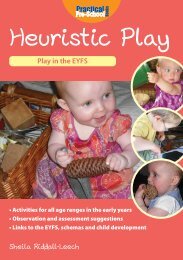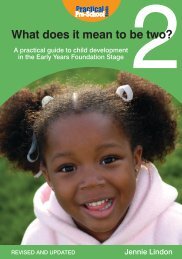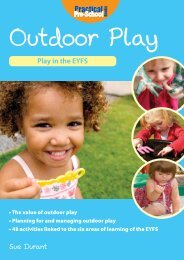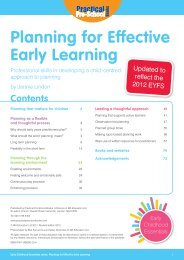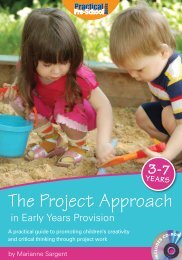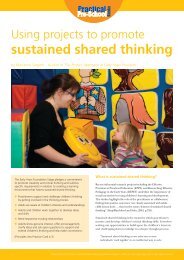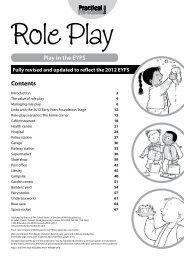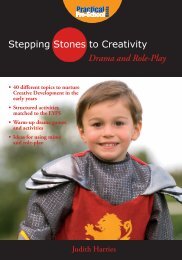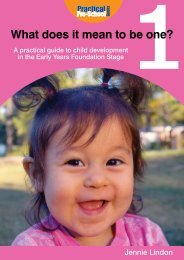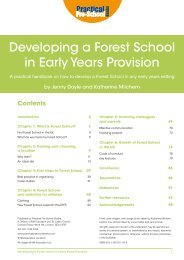Play in the EYFS Contents - Practical Pre-School Books
Play in the EYFS Contents - Practical Pre-School Books
Play in the EYFS Contents - Practical Pre-School Books
Create successful ePaper yourself
Turn your PDF publications into a flip-book with our unique Google optimized e-Paper software.
Curriculum l<strong>in</strong>ks<br />
With <strong>the</strong> eagerly awaited revised Early Years Foundation<br />
Stage framework (<strong>EYFS</strong>) unveiled <strong>the</strong> fate of <strong>the</strong> early years<br />
sector is clearer. There is much to embrace <strong>in</strong> <strong>the</strong> new<br />
framework, which will come <strong>in</strong>to force <strong>in</strong> September 2012,<br />
although <strong>the</strong> closer alignment with Key Stage One will be<br />
viewed by many as retrograde (Department for Education,<br />
July 2011). For <strong>the</strong> youngest children much of <strong>the</strong> play-based<br />
ethos rema<strong>in</strong>s <strong>in</strong>tact; reduced paperwork is promised with a<br />
reduction from 69 to 17 learn<strong>in</strong>g goals; and <strong>the</strong>re is a greater<br />
emphasis upon closer work<strong>in</strong>g and communication with<br />
parents. For many practitioners <strong>the</strong> apparent downplay<strong>in</strong>g<br />
of literacy and numeracy will be welcomed. The six areas<br />
of learn<strong>in</strong>g and development are to be replaced with three<br />
prime areas of personal, social and emotional development;<br />
communication and language; and physical development.<br />
This recognises <strong>the</strong> crucial role of communication,<br />
understand<strong>in</strong>g self and o<strong>the</strong>rs and movement as lynchp<strong>in</strong>s<br />
<strong>in</strong> <strong>the</strong> development of ‘well-rounded’ children and ultimately<br />
access<strong>in</strong>g life’s opportunities. ‘Practitioners work<strong>in</strong>g with<br />
<strong>the</strong> youngest children are expected to focus strongly on <strong>the</strong><br />
three prime areas’ (Department for Education, July 2011).<br />
Literacy, Ma<strong>the</strong>matics, Understand<strong>in</strong>g <strong>the</strong> World and<br />
Expressive Arts now fall <strong>in</strong>to four specific areas of learn<strong>in</strong>g<br />
and development. For older children <strong>the</strong> balance will shift<br />
towards ’a more equal focus on all seven areas of learn<strong>in</strong>g’.<br />
In addition to <strong>the</strong> greater emphasis upon ‘teach<strong>in</strong>g’, ‘school<br />
read<strong>in</strong>ess’ and educational programmes’, <strong>the</strong> biggest change<br />
is a narrow<strong>in</strong>g <strong>in</strong> focus to ma<strong>the</strong>matical development ra<strong>the</strong>r<br />
than <strong>the</strong> problem solv<strong>in</strong>g and reason<strong>in</strong>g so abundantly <strong>in</strong><br />
evidence <strong>in</strong> children’s play and explorations. That said, <strong>the</strong><br />
review recognises <strong>the</strong> different ways <strong>in</strong> which children learn,<br />
with effective teach<strong>in</strong>g and learn<strong>in</strong>g characterised by:<br />
• <strong>Play</strong><strong>in</strong>g and explor<strong>in</strong>g<br />
• Active learn<strong>in</strong>g, and<br />
• Creat<strong>in</strong>g and th<strong>in</strong>k<strong>in</strong>g critically.<br />
All three of <strong>the</strong>se have a strong synergy with sensory play,<br />
a strength which practitioners should harness if <strong>the</strong>y are to<br />
offset some of <strong>the</strong> top-down emphasis and potential loss <strong>in</strong><br />
playfulness <strong>in</strong> <strong>the</strong> revised <strong>EYFS</strong>.<br />
A key challenge can be justify<strong>in</strong>g to parents <strong>the</strong> value of<br />
children’s play, especially messy play. The Revised <strong>EYFS</strong><br />
(Department for Education, July 2011) attaches great<br />
importance to <strong>the</strong> effective and mean<strong>in</strong>gful engagement of<br />
parents recognis<strong>in</strong>g that this is critical to <strong>the</strong> life opportunities<br />
of future generations. As <strong>the</strong> follow<strong>in</strong>g snapshots reveal,<br />
although not curriculum-led, deeply absorb<strong>in</strong>g play provides<br />
real curricular outputs without <strong>the</strong> need for expensive or<br />
specialist equipment that might alienate some. As such,<br />
sensory-rich play is a perfect vehicle for engag<strong>in</strong>g parents <strong>in</strong><br />
quality play and <strong>in</strong>teractions with <strong>the</strong>ir children and foster<strong>in</strong>g<br />
an understand<strong>in</strong>g of <strong>the</strong> benefits of play. The best learn<strong>in</strong>g is<br />
relevant, real and rooted <strong>in</strong> children’s <strong>in</strong>terests and exist<strong>in</strong>g<br />
knowledge. This def<strong>in</strong>itely doesn’t <strong>in</strong>volve treat<strong>in</strong>g different<br />
aspects of <strong>the</strong> curriculum <strong>in</strong> isolation, but it is helpful to<br />
consider how sensory play can contribute to each of <strong>the</strong><br />
prime areas, specific areas of learn<strong>in</strong>g and development and<br />
Early Learn<strong>in</strong>g Goals (identified <strong>in</strong> bold).<br />
Prime areas<br />
Personal, social and emotional<br />
development (PSED)<br />
Sand, mud, water, natural resources and a whole raft of<br />
o<strong>the</strong>r objects typically found <strong>in</strong> a treasure basket or ‘loose<br />
parts’ play are perfect for foster<strong>in</strong>g self-confidence and<br />
self-awareness; manag<strong>in</strong>g feel<strong>in</strong>gs and behaviour; and<br />
mak<strong>in</strong>g relationships. This is true for children across <strong>the</strong><br />
ages as <strong>the</strong> resources are all open-ended and <strong>the</strong>re are<br />
no right or wrong ways of play<strong>in</strong>g with <strong>the</strong>m, mak<strong>in</strong>g<br />
<strong>the</strong>m very <strong>in</strong>clusive and empower<strong>in</strong>g. Watch a child<br />
deeply engrossed <strong>in</strong> play and we ga<strong>in</strong> an <strong>in</strong>sight <strong>in</strong>to <strong>the</strong>ir<br />
personality, <strong>in</strong>terest and schemas (repeated patterns of<br />
behaviour). Susta<strong>in</strong>ed focus can be <strong>in</strong>dicative of children’s<br />
contented exploration, problem solv<strong>in</strong>g and test<strong>in</strong>g of<br />
ideas and <strong>the</strong>ories, common occurrences <strong>in</strong> sensory<br />
play. It can contribute to <strong>the</strong>ir emotional wellbe<strong>in</strong>g and<br />
understand<strong>in</strong>g of <strong>the</strong>mselves and what <strong>the</strong>y can do. If used<br />
appropriately this is especially relevant for children with<br />
sensory perception difficulties.<br />
52 Sensory <strong>Play</strong>




